Doug Downey
Allen Institute for Artificial Intelligence, Northwestern University
AstaBench: Rigorous Benchmarking of AI Agents with a Scientific Research Suite
Oct 24, 2025Abstract:AI agents hold the potential to revolutionize scientific productivity by automating literature reviews, replicating experiments, analyzing data, and even proposing new directions of inquiry; indeed, there are now many such agents, ranging from general-purpose "deep research" systems to specialized science-specific agents, such as AI Scientist and AIGS. Rigorous evaluation of these agents is critical for progress. Yet existing benchmarks fall short on several fronts: they (1) fail to provide holistic, product-informed measures of real-world use cases such as science research; (2) lack reproducible agent tools necessary for a controlled comparison of core agentic capabilities; (3) do not account for confounding variables such as model cost and tool access; (4) do not provide standardized interfaces for quick agent prototyping and evaluation; and (5) lack comprehensive baseline agents necessary to identify true advances. In response, we define principles and tooling for more rigorously benchmarking agents. Using these, we present AstaBench, a suite that provides the first holistic measure of agentic ability to perform scientific research, comprising 2400+ problems spanning the entire scientific discovery process and multiple scientific domains, and including many problems inspired by actual user requests to deployed Asta agents. Our suite comes with the first scientific research environment with production-grade search tools that enable controlled, reproducible evaluation, better accounting for confounders. Alongside, we provide a comprehensive suite of nine science-optimized classes of Asta agents and numerous baselines. Our extensive evaluation of 57 agents across 22 agent classes reveals several interesting findings, most importantly that despite meaningful progress on certain individual aspects, AI remains far from solving the challenge of science research assistance.
Demystifying Scientific Problem-Solving in LLMs by Probing Knowledge and Reasoning
Aug 26, 2025Abstract:Scientific problem solving poses unique challenges for LLMs, requiring both deep domain knowledge and the ability to apply such knowledge through complex reasoning. While automated scientific reasoners hold great promise for assisting human scientists, there is currently no widely adopted holistic benchmark for evaluating scientific reasoning, and few approaches systematically disentangle the distinct roles of knowledge and reasoning in these tasks. To address these gaps, we introduce SciReas, a diverse suite of existing benchmarks for scientific reasoning tasks, and SciReas-Pro, a selective subset that requires more complex reasoning. Our holistic evaluation surfaces insights about scientific reasoning performance that remain hidden when relying on individual benchmarks alone. We then propose KRUX, a probing framework for studying the distinct roles of reasoning and knowledge in scientific tasks. Combining the two, we conduct an in-depth analysis that yields several key findings: (1) Retrieving task-relevant knowledge from model parameters is a critical bottleneck for LLMs in scientific reasoning; (2) Reasoning models consistently benefit from external knowledge added in-context on top of the reasoning enhancement; (3) Enhancing verbalized reasoning improves LLMs' ability to surface task-relevant knowledge. Finally, we conduct a lightweight analysis, comparing our science-focused data composition with concurrent efforts on long CoT SFT, and release SciLit01, a strong 8B baseline for scientific reasoning.
SciArena: An Open Evaluation Platform for Foundation Models in Scientific Literature Tasks
Jul 01, 2025
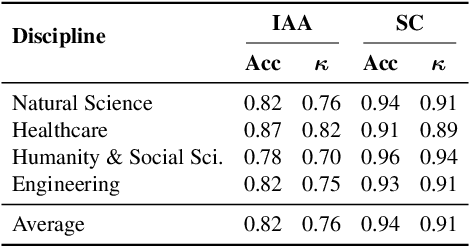

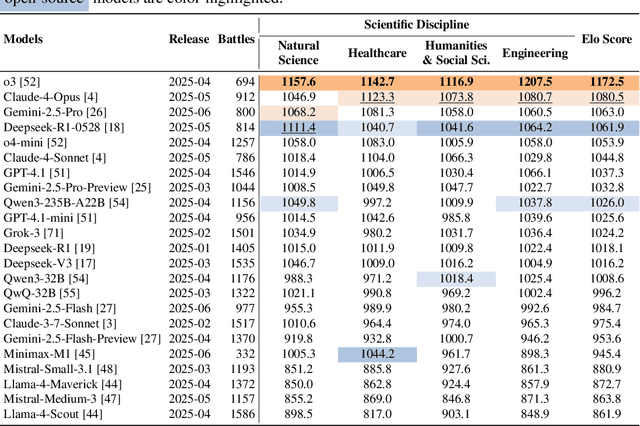
Abstract:We present SciArena, an open and collaborative platform for evaluating foundation models on scientific literature tasks. Unlike traditional benchmarks for scientific literature understanding and synthesis, SciArena engages the research community directly, following the Chatbot Arena evaluation approach of community voting on model comparisons. By leveraging collective intelligence, SciArena offers a community-driven evaluation of model performance on open-ended scientific tasks that demand literature-grounded, long-form responses. The platform currently supports 23 open-source and proprietary foundation models and has collected over 13,000 votes from trusted researchers across diverse scientific domains. We analyze the data collected so far and confirm that the submitted questions are diverse, aligned with real-world literature needs, and that participating researchers demonstrate strong self-consistency and inter-annotator agreement in their evaluations. We discuss the results and insights based on the model ranking leaderboard. To further promote research in building model-based automated evaluation systems for literature tasks, we release SciArena-Eval, a meta-evaluation benchmark based on our collected preference data. The benchmark measures the accuracy of models in judging answer quality by comparing their pairwise assessments with human votes. Our experiments highlight the benchmark's challenges and emphasize the need for more reliable automated evaluation methods.
Ai2 Scholar QA: Organized Literature Synthesis with Attribution
Apr 15, 2025Abstract:Retrieval-augmented generation is increasingly effective in answering scientific questions from literature, but many state-of-the-art systems are expensive and closed-source. We introduce Ai2 Scholar QA, a free online scientific question answering application. To facilitate research, we make our entire pipeline public: as a customizable open-source Python package and interactive web app, along with paper indexes accessible through public APIs and downloadable datasets. We describe our system in detail and present experiments analyzing its key design decisions. In an evaluation on a recent scientific QA benchmark, we find that Ai2 Scholar QA outperforms competing systems.
OpenScholar: Synthesizing Scientific Literature with Retrieval-augmented LMs
Nov 21, 2024



Abstract:Scientific progress depends on researchers' ability to synthesize the growing body of literature. Can large language models (LMs) assist scientists in this task? We introduce OpenScholar, a specialized retrieval-augmented LM that answers scientific queries by identifying relevant passages from 45 million open-access papers and synthesizing citation-backed responses. To evaluate OpenScholar, we develop ScholarQABench, the first large-scale multi-domain benchmark for literature search, comprising 2,967 expert-written queries and 208 long-form answers across computer science, physics, neuroscience, and biomedicine. On ScholarQABench, OpenScholar-8B outperforms GPT-4o by 5% and PaperQA2 by 7% in correctness, despite being a smaller, open model. While GPT4o hallucinates citations 78 to 90% of the time, OpenScholar achieves citation accuracy on par with human experts. OpenScholar's datastore, retriever, and self-feedback inference loop also improves off-the-shelf LMs: for instance, OpenScholar-GPT4o improves GPT-4o's correctness by 12%. In human evaluations, experts preferred OpenScholar-8B and OpenScholar-GPT4o responses over expert-written ones 51% and 70% of the time, respectively, compared to GPT4o's 32%. We open-source all of our code, models, datastore, data and a public demo.
SciRIFF: A Resource to Enhance Language Model Instruction-Following over Scientific Literature
Jun 10, 2024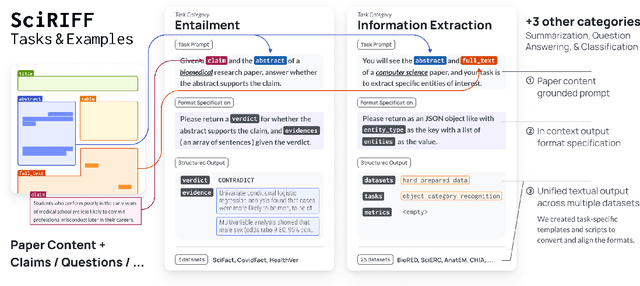
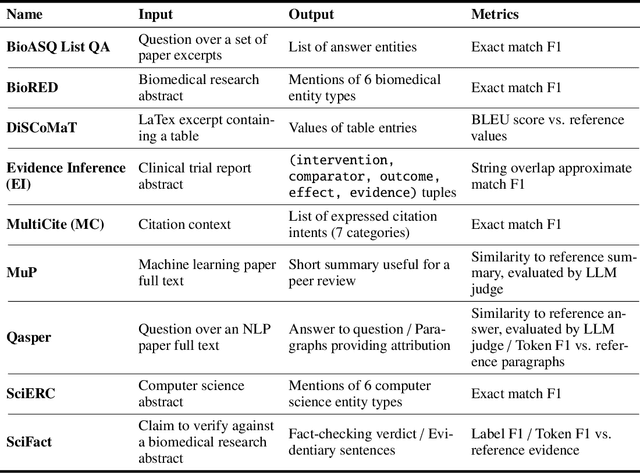


Abstract:We present SciRIFF (Scientific Resource for Instruction-Following and Finetuning), a dataset of 137K instruction-following demonstrations for 54 tasks covering five essential scientific literature understanding capabilities: information extraction, summarization, question answering, claim verification, and classification. SciRIFF demonstrations are notable for their long input contexts, detailed task specifications, and complex structured outputs. While instruction-following resources are available in specific domains such as clinical medicine and chemistry, SciRIFF is the first dataset focused on extracting and synthesizing information from research literature across a wide range of scientific fields. To demonstrate the utility of SciRIFF, we develop a sample-efficient strategy to adapt a general instruction-following model for science by performing additional finetuning on a mix of general-domain and SciRIFF demonstrations. In evaluations on nine held-out scientific tasks, our model -- called SciTulu -- improves over a strong LLM baseline by 28.1% and 6.5% at the 7B and 70B scales respectively, while maintaining general instruction-following performance within 2% of the baseline. We are optimistic that SciRIFF will facilitate the development and evaluation of LLMs to help researchers navigate the ever-growing body of scientific literature. We release our dataset, model checkpoints, and data processing and evaluation code to enable further research.
TOPICAL: TOPIC Pages AutomagicaLly
May 03, 2024


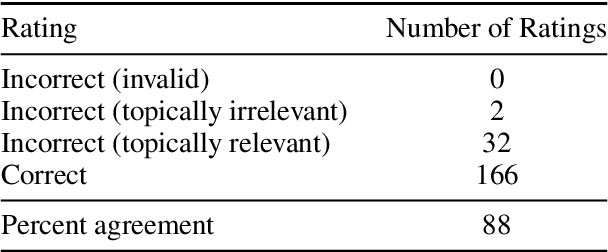
Abstract:Topic pages aggregate useful information about an entity or concept into a single succinct and accessible article. Automated creation of topic pages would enable their rapid curation as information resources, providing an alternative to traditional web search. While most prior work has focused on generating topic pages about biographical entities, in this work, we develop a completely automated process to generate high-quality topic pages for scientific entities, with a focus on biomedical concepts. We release TOPICAL, a web app and associated open-source code, comprising a model pipeline combining retrieval, clustering, and prompting, that makes it easy for anyone to generate topic pages for a wide variety of biomedical entities on demand. In a human evaluation of 150 diverse topic pages generated using TOPICAL, we find that the vast majority were considered relevant, accurate, and coherent, with correct supporting citations. We make all code publicly available and host a free-to-use web app at: https://s2-topical.apps.allenai.org
MARG: Multi-Agent Review Generation for Scientific Papers
Jan 08, 2024Abstract:We study the ability of LLMs to generate feedback for scientific papers and develop MARG, a feedback generation approach using multiple LLM instances that engage in internal discussion. By distributing paper text across agents, MARG can consume the full text of papers beyond the input length limitations of the base LLM, and by specializing agents and incorporating sub-tasks tailored to different comment types (experiments, clarity, impact) it improves the helpfulness and specificity of feedback. In a user study, baseline methods using GPT-4 were rated as producing generic or very generic comments more than half the time, and only 1.7 comments per paper were rated as good overall in the best baseline. Our system substantially improves the ability of GPT-4 to generate specific and helpful feedback, reducing the rate of generic comments from 60% to 29% and generating 3.7 good comments per paper (a 2.2x improvement).
CHAMP: Efficient Annotation and Consolidation of Cluster Hierarchies
Nov 19, 2023Abstract:Various NLP tasks require a complex hierarchical structure over nodes, where each node is a cluster of items. Examples include generating entailment graphs, hierarchical cross-document coreference resolution, annotating event and subevent relations, etc. To enable efficient annotation of such hierarchical structures, we release CHAMP, an open source tool allowing to incrementally construct both clusters and hierarchy simultaneously over any type of texts. This incremental approach significantly reduces annotation time compared to the common pairwise annotation approach and also guarantees maintaining transitivity at the cluster and hierarchy levels. Furthermore, CHAMP includes a consolidation mode, where an adjudicator can easily compare multiple cluster hierarchy annotations and resolve disagreements.
CARE: Extracting Experimental Findings From Clinical Literature
Nov 16, 2023Abstract:Extracting fine-grained experimental findings from literature can provide massive utility for scientific applications. Prior work has focused on developing annotation schemas and datasets for limited aspects of this problem, leading to simpler information extraction datasets which do not capture the real-world complexity and nuance required for this task. Focusing on biomedicine, this work presents CARE (Clinical Aggregation-oriented Result Extraction) -- a new IE dataset for the task of extracting clinical findings. We develop a new annotation schema capturing fine-grained findings as n-ary relations between entities and attributes, which includes phenomena challenging for current IE systems such as discontinuous entity spans, nested relations, and variable arity n-ary relations. Using this schema, we collect extensive annotations for 700 abstracts from two sources: clinical trials and case reports. We also benchmark the performance of various state-of-the-art IE systems on our dataset, including extractive models and generative LLMs in fully supervised and limited data settings. Our results demonstrate the difficulty of our dataset -- even SOTA models such as GPT4 struggle, particularly on relation extraction. We release our annotation schema and CARE to encourage further research on extracting and aggregating scientific findings from literature.
 Add to Chrome
Add to Chrome Add to Firefox
Add to Firefox Add to Edge
Add to Edge